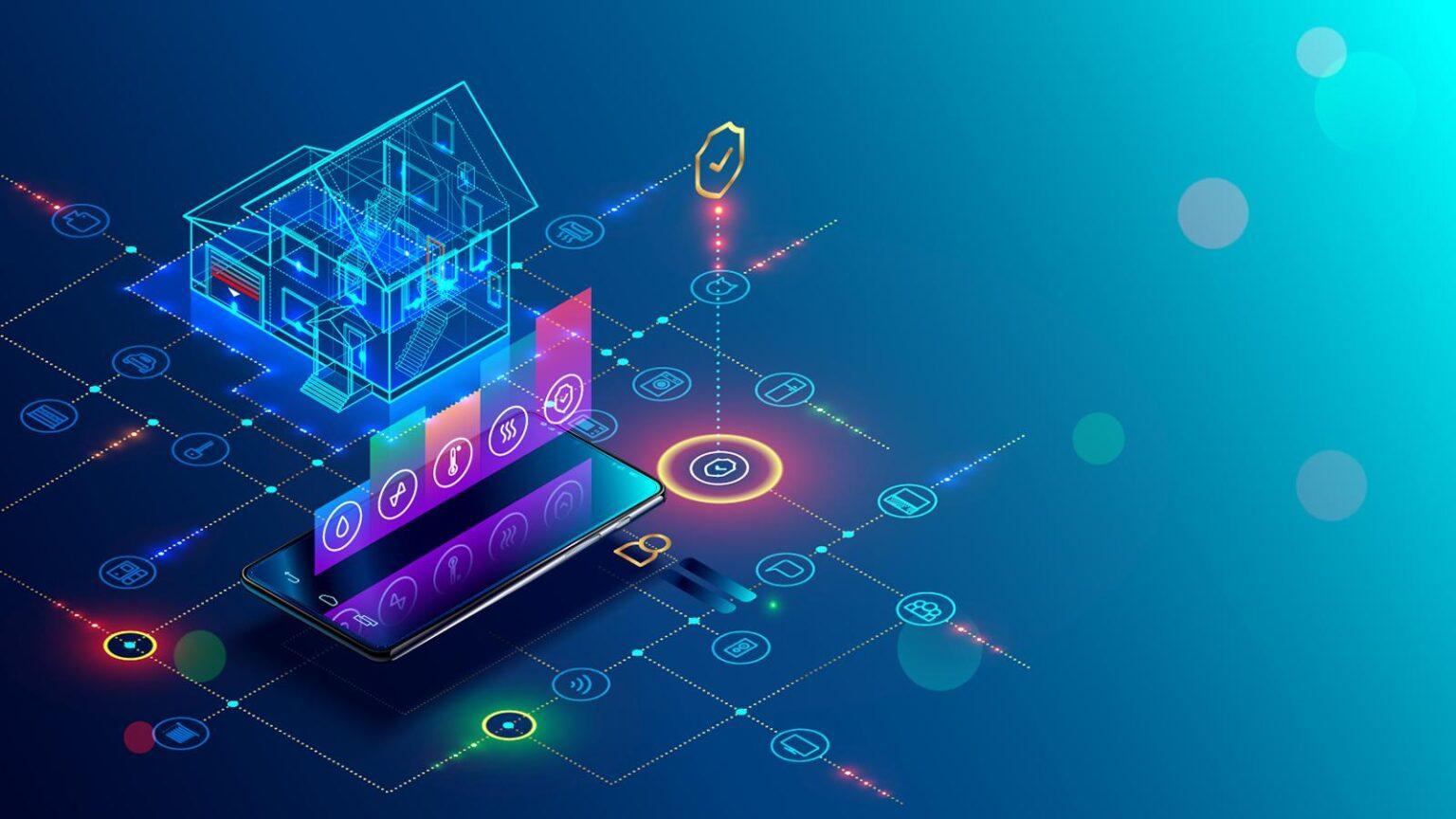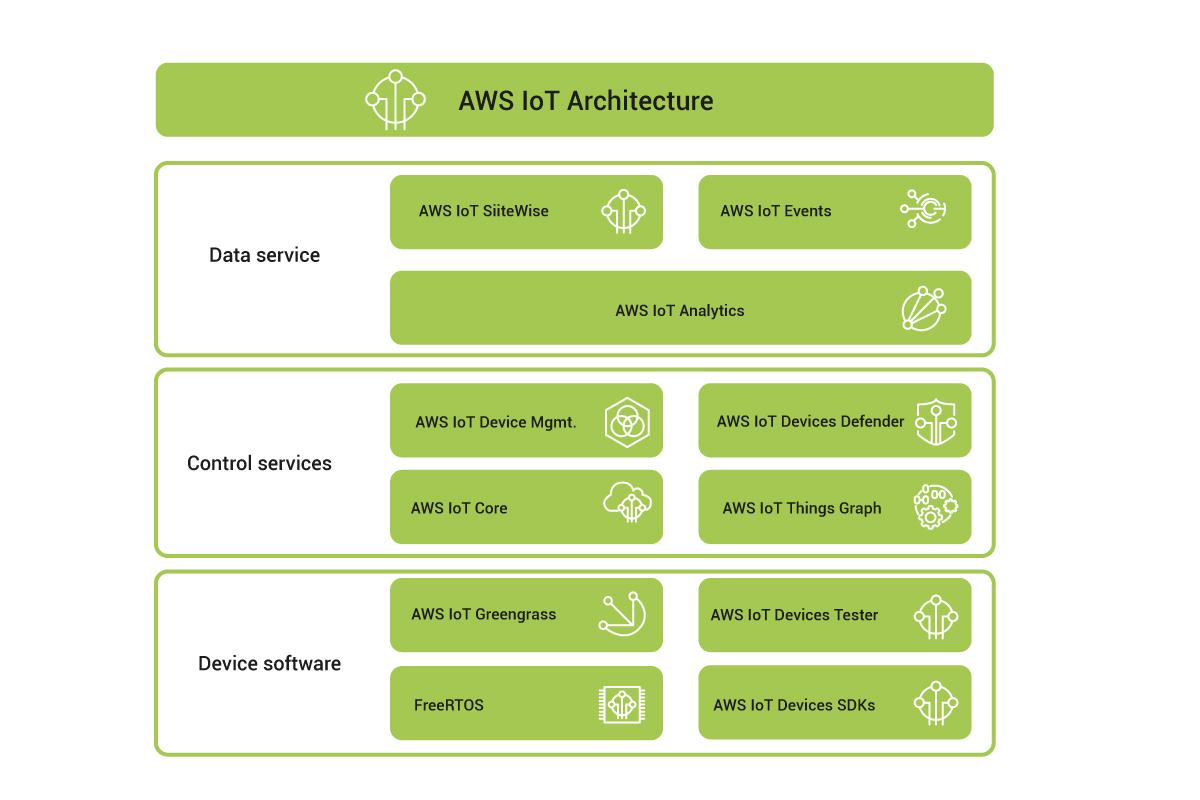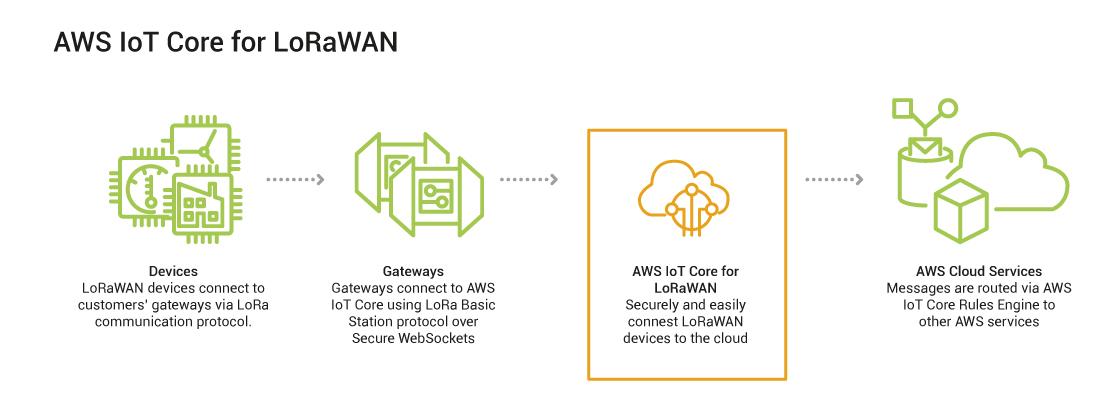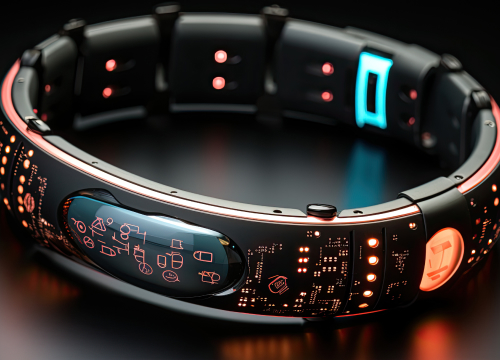
AWS IoT Core: Full Guide

AWS IoT Core is the undisputed leader among today’s cloud integration tools. Due to its efficiency and reliability, AWS was named the Best Consumer IoT Solution in 2020 and continues to dominate the middleware market today with a 37% value share.
Amazon Web Services IoT platform brings together over 200 full-featured services that are great at connecting billions of devices to the cloud, coordinating networks, and protecting data to enable projects of any complexity and scale. That is why they are used by giants such as Volkswagen, Honda, Siemens, Phillips, LG, Carrier, as well as cutting-edge startups and large government agencies around the world.
With years of experience in cloud development at Sirin Software, we have come up with our own AWS IoT platform guide to help you get a real sense of what this solution can do and make the most of it to lower costs, increase agility, and accelerate innovation.

Major Benefits of AWS IoT Platform
The platform delivers reliability and performance coupled with data collection capabilities based on AWS core principles:
- Scalability
- Stability
- Safety
More particularly, the main benefits of the platform include the following.
Serverless architecture
Flexible and fast development provides:
- making the code available in AWS Lambda where it can be executed immediately;
- shadow hardware management, etc.
This reduces the cost of the MVP and allows an IoT software development company to focus on other tasks without getting buried in server maintenance.
High-quality analytics
AWS IoT platform provides a list of powerful tools for data analysis in the IoT ecosystem. Raw data is easily converted into valuable material for calculations, extraction and preparation for machine learning.
High security standards
Strict access control allows you to set up multi-factor authentication and define user roles. The system constantly monitors software performance and detects suspicious activity. Thus, complete protection and secure communication between the platform and connected devices is ensured.
Wide pool of partners
Third-party vendors ensure full hardware and application compatibility across proprietary cloud infrastructure.
Complete integration
IoT software development companies are not limited to use other web services. You don’t need to switch to another service to add new features. Using AI to customize data storage and processing models allows you to customize scripts that run automatically in the cloud. This is where our cloud development service becomes instrumental, offering tailored solutions to optimize your cloud-based operations and workflows. To add machine learning, we recommend using SageMaker. To increase the data storage – S3.
Flexible pricing
The basic cost of AWS IoT services depends on several factors, but in any case, it is not high. You only pay for what you use at affordable rates with no upfront commitments or default fees.

AWS IoT Services

AWS IoT Services offer countless features and can work with an unlimited number of connections. This allows IoT software development companies to provide solutions of any complexity for any area without additional changes in the management infrastructure.
Program tools
FreeRTOS
An MIT-licensed open-source operating system that has become the standard for a wide range of small peripherals. Distributed for free, it includes a core and a rich set of libraries used to connect not only to AWS IoT Core but also to many other services. You can instantly download code and compile it to accelerate time-to-market.
IoT Greengrass
An open-source edge runtime for building, deploying, and managing devices in the cloud. You can deploy software applications using any language and compression technology.
Device tester
The microcontroller test automation tool will check your device for the ability to run FreeRTOS in the cloud and interact with other services. You can deploy, manage, and configure devices remotely at any scale without having to update the firmware. Transferring cloud processes and logic to local peripherals will save you from dependence on a stable connection.
SDK for devices
The main task of the software development kit is to provide direct assistance in connecting devices. The open-source libraries and example guides they contain make it easy to implement on existing hardware.
Control elements
IoT Core
Cloud Connectivity Core Service secures communications securely and has the bandwidth to handle multiple connections quickly.
AWS IoT device manager
An effective solution for monitoring and performing operations in the system. You can register connected devices one by one or in batches. You can also track functionality, troubleshoot issues, and send OTA updates. The service does not depend on the type of OS and allows you to save resources when scaling systems.
Device Defender
Guarantees 100% protection of your system from any troubles. A managed service continuously audits device configurations, device behavior, and protects them from hacking or misuse.
IoT 1‑Click
Allows you to run AWS Lambda functions on simple devices with one click. Devices can send notifications to technical support, track resources, and update products or services. They require no additional configuration, eliminating the need to create your own firmware or set up a secure connection. Built-in reports allow you to track status. You do not need to create, install, or manage certificates.
Data
IoT Analytics
Provides the ability to perform complex evaluations of large volumes of data without a native analytics analytics platform. Enables you to make more accurate decisions on the use of new products.
AWS IoT Wise website
It is responsible for the collection, systematization, and analysis of data from industrial equipment. Simplifies routing, speeds up the process of identifying and resolving problems with sensors. You can process data on-premises and create hybrid applications that run both at the edge and in the cloud.
Events
Data patterns that detect changes in the state of equipment. Allows you to select data sources, define the logic for each event, select a warning or default action in each case. The service automatically responds to events based on the logic you specify in order to quickly resolve problems that arise.
IoT Things Graph
Provides a graphical interface for customizing interaction using models. Allows you to set up and configure interaction between devices and web services using drag and drop. This reduces the code requirements for building applications. Models hide base-layer characteristics such as protocols and interfaces and make it easy to integrate features into complex workflows.

How Does Amazon IoT Core Work?
The cloud service connects devices and ensures the security of data exchange. When the device is connected to the cloud, it responds to requests and works with the functionality of the application, making it easy to use and reducing response time. This allows you to operate data even in the absence of an Internet connection, as well as produce inexpensive devices with a built-in Alexa voice assistant.

Major features and capacities of AWS IoT Core Components include the following.
SDK
Grants fast connection and authentication of devices, as well as messaging with the platform using the most efficient protocols ─ MQTT, HTTP, and WebSockets. Supports the most popular languages ─ C, JavaScript, and Arduino.
Device configuration wizard
Helps to test IoT devices during development. Ready-made tests check the reliability and security of the connection, as well as the readiness to interact with the kernel, taking into account security recommendations. Thus, software problems can be identified and resolved before devices are deployed.
Device gateway
The entry point manages all active devices. It supports long-term bidirectional connections. Automatically scales, enables infrastructure migration with minimal impact on application architecture.
Message Broker

Enables low-latency messaging with any number of devices. Supports message transmission patterns from individual command-and-control to broadcast. Automatically scales without requiring you to run another infrastructure.
Authentication and authorization
Amazon IoT Core supports the following authentication methods:
- SigV4;
- based on an X.509 certificate;
- token-based (via custom authorization modules).
AWS IoT Core Components allow you to use certificates generated by the service and also signed by a selected CA. You can bind selected policies to each certificate to grant and revoke authorized access.
Registry
Allows you to track and store metadata such as device attributes or capabilities. Does not require an additional fee. To prevent the saved data from being deleted, it is enough to access the registry entry once every 7 years.
Device shadows

Amazon IoT Core allows you to create a shadow, a virtual image of a device containing its latest state, even when offline (free for a year). Interestingly, using the API or rules service, you can get the last registered or set the desired future state for the device.
The use of shadows simplifies the creation of applications due to the presence of always available REST APIs. Using the SDK, you can easily synchronize the state of devices with their shadows and adjust them according to the requirements for future states.
Rules service
Evaluates incoming messages published to Amazon IoT Core and then transforms and delivers them to another device or cloud service based on business rules that you define.
The service can route messages to external addresses. Rules are written using the management console or using SQL-like syntax.

Allows you to scale production and reduce the time-to-market of products with voice control. All work is done in the cloud, reducing production costs by 50%.

Supports open-source connection protocol. You can set up a long-range private network by connecting high-performance devices to a cloud server. This will reduce the operational burden of managing the LNS and reduce network setup time.
Connection does not require writing or testing special gateway software. Device data is automatically routed to the rules service, speeding up application development.
Amazon Sidewalk
Sidewalk’s free network makes it easy to set up new ones, extend the range of low-bandwidth devices, and help them stay online outside of your home Wi-Fi network.
Essential aspects
The cloud gateway does not require a single communication protocol, but provides efficient and secure communication. Amazon Web Services IoT platform filters, processes, and redirects data to other services as needed ─ Lambda, Kinesis, etc. Registration and tracking of connected objects occurs in a special registry.
The device shadow allows you to request submitted data and send commands to devices using the underlying API gateway. You can link devices using a suitable SDK, such as Python or Arduino. You can also create applications, connect, and manage devices regardless of geography.
How to Use AWS IoT Core Components
Register your devices to get started. You can skip this step if you already have an IAM and AWS account. In it, you need to select and configure the desired functions.
Registration
The management console allows you to easily and securely create (command ─ create-thing) and validate (list-thing) a thing, bind a certificate, publish messages, and set the required actions. Batch adding of objects is available. To combine devices and apply the same command to all, create groups.
Configuration
Next, you need to prepare the device for use:
- Make entries in the device registry. Each element gets a unique name and a set of attributes. Things are identified by type or grouped.
- Create a primary X.509 digital certificate or copy an existing one.
- Add IoT policies to the certificate so that the device can communicate. If there are a lot of them, you can do it automatically through Timely Registration (JITR) and Provisioning (JITP).
- Create an Analytics app to process data in the console. We recommend Kinesis and Go to Analytics Console, and IoT-Source-Stream as a source.
- Select Schema Detection to allow Google Analytics to fetch from the input.
Keep in mind that the SDK makes writing code easier by providing APIs for various AWS IoT services. A package with the library code and code samples is available for download. Simple interaction with the gateway and device shadow allows you to quickly move to the development stage and reduce its cost.
With the modular Device Client, you can easily connect devices and use the default Device Management and Device Defender features. The software is written in C++ and can be compiled and installed on Embedded Linux devices. The source code is available for download at GitHub.

Device Management
You may perform batch updates, monitor deployment rates, set error thresholds, and assign persistent jobs to automatically update device software.
In case of security issues, the device is rebooted or reset to factory settings. If the state changes, the application uses the RESTful API to request an update, and the framework synchronizes the desired state with the thing. When the connected thing updates the state to the desired shape, the app is notified.
A couple of examples from our own practice will help you understand how efficiently all that works in real life.
The client needed a smartwatch solution to communicate location coordinates to wearers in case of an emergency. The customer requested that the connection standards be updated to be compatible with any country in the world and to eliminate possible errors with different networks.
Our team has updated LoRa so that the smartwatch can work seamlessly in any country. The required changes clashed with other performance processes, so our engineers changed the logic of their work with the help of modern technologies. As a result, the communication between the device and the server has been improved and the SKU setup has been optimized.
In another case, it was necessary to increase the scalability of the existing cloud system for IoT products. We used AWS infrastructure (S3, EC2, ECS, Fargate, Lambda, RDS Aurora, DynamoDB, DocumentDB, SNS, SQS, CloudWatch, CodeBuild, CodeDeploy, CodePipeline, Cognito, API Gateway, Route 53, CloudFront) and Node.js language, React.js.
All in all, we were able to optimize the system by increasing the number of requests per minute and the potential for rapid cloud scalability. This allowed the client to reduce the number of servers and save up to 30% of costs.
Summary
The Amazon Web Services IoT platform is the ultimate set of tools for connecting and deploying IoT at any scale. Managed end-to-end infrastructure helps rapid business growth. Multiple authorization levels ensure secure communication between the platform and connected devices. The control mechanism allows you to modify and direct the data received from devices to other services.
Thus, the platform helps shorten time-to-market, simplifies documentation and maintenance of the product after the release.
Do you want your project to develop steadily and sustainably? Contact us at Sirin Software and our experts will tailor AWS IoT Core to your needs.



